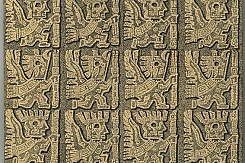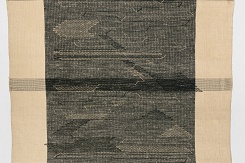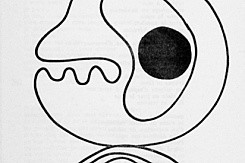Gerhard Marcks’ intense relationship with and knowledge of ancient Greek culture and art is well known and is also reflected in the Dornburg ceramics—for example, in the proportions and expressive silhouettes of vessels or decorations, whether with lines that support form or in archaically-styled figurative scenes. He also incorporated whimsical sayings common to traditional, domestic vessels. Thus, vessel-sculptures created in the Dornburg workshop exhibit a spectacular combination of traditional domestic vessel forms and decorative motifs—as well as a variety of international inspirations—in order to explore and experiment with changes in form. As demonstrations of artistic imagination and craftsmanship, their value lay in their perceptual properties rather than their practical use. This corresponded neither to the basic idea of Gropius, nor to how a conventional ceramic workshop is run. However, basic design knowledge and a thorough learning of the pottery trade—including turning, glazing and painting, as well as mastery of the kiln—was still imparted, forming the prerequisites skills for those later Bauhaus products, whose masterfully balanced design and high utility value made them classics of twentieth century modernity. These include Otto Lindig’s Kanne L16 and Vase L59, which he later wrote were the best he ever made, Theodor Bogler’s storage jars and Marguerite Friedlaender’s Hallesche Form service ware and vases, designed for the Staatliche Porzellanmanufaktur Berlin.
The fact that Bauhaus ceramics did not become more widespread was due to the relatively short duration of the Dornburg workshop’s existence, during which time its products were unable to be scaled to industrial production. The workshop was an educational facility, operating at a relatively low technical level, and therefore could not achieve any relevant production output of sufficiently high quality. In addition, Thuringia’s small and medium-sized porcelain industry was reluctant to take on Bauhaus models.
The End of Ceramic Work at the Bauhaus
With the abandonment of the State Bauhaus in Weimar in 1925 and its subsequent move to Dessau, the hopeful development of the Dornburg workshop broke down completely. To this day, the reasons why a ceramics workshop was not set up in Dessau are not fully known, even though the workshop in Dornburg was on the verge of industrial series production.
Gerhard Marks, Marguerite Friedlaender, Frans Wildenhain and later Wilhelm Löber all moved to Burg Giebichenstein in Halle. Theodor Bogler (the brother-in-law of Otto Lindig) became artistic director of the stoneware factories Velten-Vordamm. Otto Lindig remained in Dornburg as head of the ceramic workshop of the State Building School of Weimar, the successor of the Bauhaus, as did fellow Bauhaus ceramicist Werner Burri, until he succeeded Bogler in Velten-Vordamm in 1928. Burri, a Swiss citizen, returned to his native country in 1939. In 1930 Otto Lindig leased the Dornburg workshop, running it as a commercial pottery until he moved to the Landeskunstschule Hamburg in 1947.
However, the abrupt discontinuation of the ceramic work at the Bauhaus did not, in the end, mean the pioneering achievements in ceramics that had been made there were lost. The leading graduates and their master of form influenced both national and international ceramics with their own work and as teachers—of course due to the pressure of drastic political changes. The ceramists returned to the world from the small East Thuringian workshop located away from all major metropolises in a variety of ways.
Influence of Bauhaus Ceramists after 1925 in Germany
Otto Lindig played the greatest part in spreading the Bauhaus idea in his own country through his teacher training at the Bauhaus, his own workshop work from 1930–47 and, from 1947, through his professorship at the Landeskunstschule Hamburg8 (as well as through his design work for the Majolika ceramics manufactory in Karlsruhe). In the products and in what he conveyed to his numerous students and apprentices, the Bauhaus idea not only continued to live on, it multiplied itself again in their production and their subsequent training of aspiring ceramicists.9



















_crop.jpg?w=245&h=163&c=1)
















 Kopie.jpg?w=245&h=163&c=1)














